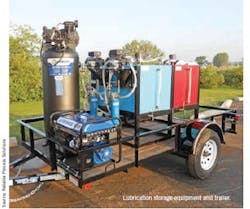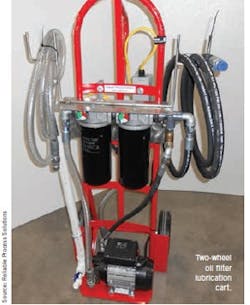Lubrication management is far more important than most people realize. Those who get it are implementing innovations that make it much easier to answer “yes” to these basic questions: Is the correct machine lubricant known and available when needed? Is it clean of any contaminants and stored safely in a cool and dry place?
Unfortunately, optimization efforts lag when the role is underappreciated. “I think the industry as a whole has not fully realized how much lubrication can impact the bottom dollar when done correctly,” says Wesley Cash, director of technical services at Noria.
Lubrication priorities at USG Interiors, Cloquet
- Lubrication labeling is done plantwide
- Oil analysis is only done on equipment deemed critical to operations
- Ultrasonic lubrication and monitoring is primarily on equipment deemed critical
- Desiccant breathers are used plantwide where deemed necessary
When lubrication is done inconsistently or incorrectly, it negatively affects machine condition and reliability plant-wide, explains Yolanda Diaz, zone technical expert for lubrication at Anheuser-Busch InBev.
USG Interiors, Wells Enterprises, and AB InBev are among the manufacturers utilizing modern tools, services, and strategies in their lubrication programs. Consider their experiences and advice as well as those of industry lubrication experts when working to shape your optimization priorities.
Polished process for building products
Josh Mattson, reliability supervisor at the USG Interiors plant in Cloquet, MN, believes the most valuable component of any lubrication program is the lubrication technician who champions the program. That person must understand the processes, strategies, and benefits of lubrication and receive continuous education on lubrication and oil analysis. Also, he or she must be engaged and empowered to take the lead on monitoring and improving the processes. “This is what our lubrication technician, Dave Mickle, MLT I, brings to our program,” says Mattson.
The Cloquet plant engaged a third party to audit its equipment and lubricants for accuracy and consolidation opportunities. Its oil storage is clean and organized based on 5S standards, and new oil containers are prefiltered before the oil is used. “We filter a new oil barrel 5-7 times before it is put into use,” says Mattson.
For oil analysis, a third-party service has proved cost-effective. Oil changes are based on sampling analysis results rather than on the calendar. Sampling ports are separate from the fill and drain ports to avoid contamination.
Optimization technologies used at USG Interiors in Cloquet include Ultraprobes from UE Systems for ultrasonic monitoring and lubrication; Des-Case desiccant breathers and oil filtration units; vacuum-charged Simplo Jars from RelyAssist for oil sampling in highly contaminated and restrictive areas; quick-connect hookups for filling, draining, filtering, and sampling; and sight tubes/glasses.
Following are Mattson’s recommendations:
- Get a certified Machinery Lubrication Technician Level I (MLT I) in place
- Get management on board with the costs necessary to start the program and strategies to launch and maintain it
- Develop ultrasonic lubrication and monitoring routes, which will work hand-in-hand to strengthen your plant’s reliability strategies
- Encourage ownership and engagement at all levels
Smooth operations for ice-cold environment
Wells Enterprises, best known for its Blue Bunny ice cream brand, audits its lubrication program twice per year to look for improvement opportunities. Don Palmer, reliability analyst at Wells Enterprises, considers the following some of Wells’ most effective lubrication practices:
- An in-house oil analysis laboratory allows for the testing of equipment on regular routes as well as unscheduled testing while troubleshooting equipment problems. Additionally, all new oils are tested to verify cleanliness and to confirm they meet specifications. “Our in-house oil lab tests 1,200 to 1,300 oil samples per year,” says Palmer.
- Oil filtration units, both portable and permanent, are used to remove contamination from gearboxes, hydraulic systems, and compressors. Currently, 75 oil filtration units are used on critical equipment.
- Improved oil sump breathers are used to prevent contamination ingression into the lubricants. “Last year we conducted a contamination study of our active gearboxes and came up with 63 units to implement contamination control upgrades to,” Palmer says.
- Grease analysis testing is used to determine ferrous wear materials in critical bearings. “This was implemented two years ago and has been very successful at a low cost of testing,” explains Palmer. “We currently use the grease testing in three blast freezing locations at -45°F, and we are adding 32 more grease points this year in two additional blast freezing machines.”
Start slow, Palmer advises. “It is very hard to implement a full program and sustain it,” he says. “You need one person to be the program champion and drive towards excellence.” Documentation is important, even if it’s no one’s favorite task. He suggests taking pictures of good and poor lubrication practices and using them as training examples.
Slick practices for world's largest brewer
AB InBev has been standardizing its lubrication practices globally to improve efficiency and increase equipment reliability and uptime. In recognition of these efforts, the AB InBev lubrication team, including Diaz, won Uptime magazine’s 2017 award for Best Lubrication for Reliability Program.
The team first established a toolkit of lubrication and oil analysis standards as well as good operating practices (GOP) to measure progress toward lubrication targets. The goal was to optimize all lubrication processes, from the inspection, testing, storage, and 5S organization of new lubricants to the training of new equipment lubrication processes for all operators on all shifts, and continuing through lubricant application, maintenance, and disposal.
SAP asset management software drives the lubrication routes and provides detailed instructions with measurement points for inspections and corrective work orders. Automatic lubrication systems are used to expedite inspections and reduce the mean time to repair (MTTR). Filtration systems, clear-bodied grease guns, and desiccant breathers also are employed in AB InBev’s lubrication program.
“Year-to-date, each zone has made big improvements in lubrication management,” says Diaz. “We have approximately 230 plants executing this toolkit today, and each one is working to the same standards.” It is viewed as a huge enabler for reaching their lubrication targets as “we know that 40% of failures are proven to come from lubrication issues, such as no lube, the wrong lube, or contaminated lubes,” she explains.
Diaz recommends designing a master guide/toolkit of lubrication and oil analysis standards, establishing GOPs to assess and measure tangible gaps, and having a lubrication target.
Insights from industry advocates
For companies wanting to improve their lubrication knowledge, skills, and industry practices, look to organizations such as Noria, Reliable Process Solutions, and Advanced Machine Reliability Resources (AMRRI) for help.
Terry Harris, president of Reliable Process Solutions, urges analysis to determine whether new lubricants are clean and dry and have the proper viscosity and additive packages. Those that aren’t stored correctly “can pick up foreign material and moisture if open containers and random jugs are used,” he cautions.
Filtration of new lubricants using mobile oil filter carts or lubrication storage room filtration and recycling equipment is a very effective and beneficial process, says Harris.
He suggests that to help keep the lubricants clean and dry, clean lubrication storage rooms with self-contained lubrication storage and filtration units be used, with IsoLink containers for transport used around the facilities. He also recommends desiccant breathers to help keep particles and moisture out of operating equipment that starts and stops often and/or is situated in a dirty or humid area.
Noria’s Cash says, “If you haven’t looked at lubrication in a while, it will blow your mind what’s out there.” He views software-enabled lubrication optimization as the biggest opportunity. The software tells users when, where, and how often to apply lubricants and helps drive the metrics and accountability for a lubrication program.
On-site testing and on-site laboratory analysis have come a long way and provide “a much greater degree of certainty of what’s going on inside the equipment based upon oil sample results,” says Cash. He cautions that in-house oil analysis should never be a replacement for third-party oil labs; they should be used in tandem.
Visual inspections are a great predictive tool. Look at the site glass not only for the current oil level but also for changes to the level and whether the oil is dark, cloudy, or shows signs of water. When looking at desiccant breathers, check if it is changing color in the appropriate direction (bottom-up or top-down), suggests Cash.
Lastly, to keep up with the different tools, processes, and techniques coming out at a rapid pace, Cash encourages subscribing to trade publications, going to conferences every year, and getting regular training. “Everyone needs some level of training based upon the tasks they do,” he says.






